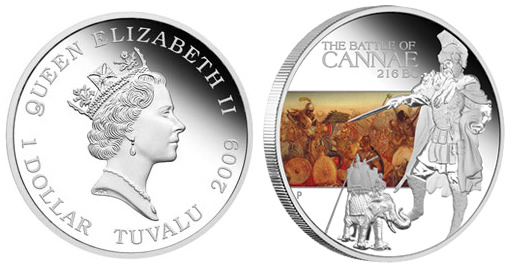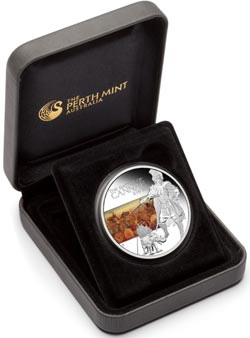Offering the second coin in their Famous Battles series, The Perth Mint of Australia on Friday introduced the Battle of Cannae 216 BC 1 OZ Silver Proof Coin with a limited worldwide mintage of just 5,000. The Famous Battles series was launched with the Battle of Thermopylae 480BC coin, which met high demand and has already sold out.

The Battle of Cannae was a crushing defeat of the Roman army at the hands of Hannibal and his Carthaginian army. This battle would be the template of which many future commanders would strive to achieve. Dwight D. Eisenhower, the Supreme Commander of the Allied Expeditionary Force in World War II, once wrote:
"Every ground commander seeks the battle of annihilation; so far as conditions permit, he tries to duplicate in modern war the classic example of Cannae"
Hannibal’s army, which included his famous war elephants, was continually making advances into Roman territory. In an effort to stop the unwanted approach, the Romans amassed an army estimated at an almost 90,000 strong. Hannibal’s forces were said to be less than half that.
Contemporary accounts of the battle are non-existent, but Hannibal is said to have employed the tactic known as the pincer movement or double envelopment. With this maneuver, the flanks of an enemy are attacked while still engaging the main force. Once the flanks have been defeated, the conquering forces are allowed to meet behind the enemy, effectively encircling them.
Owing to many factors, including an over-confidence on the part of the Roman army, the Carthaginians were victorious. Th exact numbers of casualties are unknown, but the Romans are believed to have lost tens of thousands of soldiers. It is regarded as one of the greatest tactical victories in military history, and was a crushing blow to the Roman morale.
"Never before, while the City itself was still safe, had there been such excitement and panic within its walls," a historian known as Livy wrote two centuries later. "Certainly there is no other nation that would not have succumbed beneath such a weight of calamity."
Coin specifications, design, price and order details
 The Perth Mint coin dedicated to this battle is issued in 1 oz. of proof quality 99.9% pure silver.
The Perth Mint coin dedicated to this battle is issued in 1 oz. of proof quality 99.9% pure silver.
It has a minimum weight of 31.135 grams, with a diameter of 40.6 mm, a thickness of 4 mm, and is issued under the authority of the government of Tuvalu as legal tender.
The reverse or tails side of the Cannae coin portrays a Carthaginian warrior along with one of Hannibal’s famous war elephants. To the left is a colored depiction of the deadly battle. Included as well are the inscriptions "The Battle of Cannae" and "216 BC."
The obverse shows Raphael Maklouf’s effigy of Her Majesty Queen Elizabeth II. Inscribed are "Queen Elizabeth II", "Tuvalu", "2009" and the denomination "1 Dollar."
Those ordering the coin for AUS $81.36 (~$63 US) will find it comes in an illustrated box with a presentation case and a numbered Certificate of Authenticity.
The remaining three coins of the series will include the Battle of Hastings 1066, the Battle of Balaclava 1854, and the Battle of Gettysburg 1863.
Orders may be placed online through the Perth Mint page:
The Battle of Cannae 216 BC 1oz Silver Proof Coin
(CoinNews affiliate link)
About the Perth Mint
The Perth Mint, wholly-owned by the State Government of Western Australia, is the official issuer of the Australian Federal Government’s Gold and Silver Bullion Coin Program. The Mint opened in 1899 in response to the discovery of rich gold deposits in Coolgardie and Kalgoorlie. It was Australia’s third branch of Britain’s Royal Mint – the others being the Sydney Mint and the Melbourne Mint (both closed).
The Perth Mint remained under Britain’s jurisdiction until 1 July 1970, when ownership transferred to the State Government of Western Australia.
In 2003, The Perth Mint officially opened an 8,400 square metre state-of-the-art manufacturing facility next door to its original limestone building. Dominating the Mint’s heritage precinct, these two important buildings are powerful symbols of more than 100 years of minting excellence in Western Australia.





